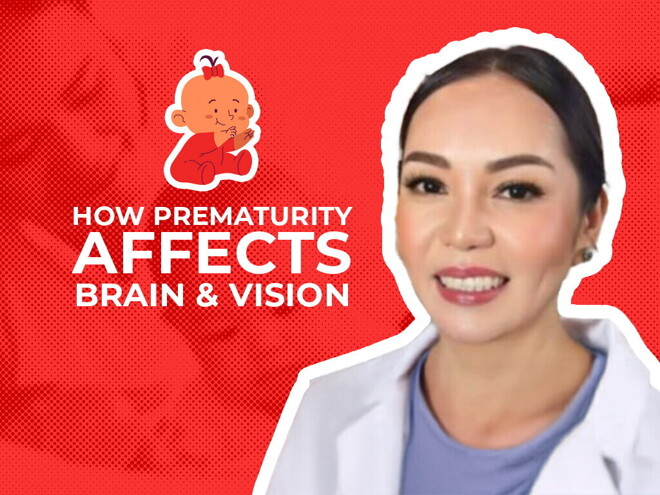
Brain and Visual Development in Preterm Babies
Janet Marriane Go-Nierva, MD, FPPS, FPSNbM
Neonatologist
What is preterm birth?
Preterm birth is when a baby is born before 37 weeks of pregnancy.1
What are the different types of preterm birth?
The American Academy of Pediatrics (AAP) categorizes preterm births into the following groups based on gestational age:1
- Late preterm: Born between 34 and 36 weeks
- Moderately preterm: Born between 32 and 34 weeks
- Very preterm: Born between 28 and 32 weeks
- Extremely preterm: Born before 28 weeks
How does prematurity impact brain and visual development?
- Premature babies may have smaller brain volumes, altered white matter structure, and potentially disrupted neural connections in areas crucial for vision, impacting how visual information is processed.2
- Premature birth can significantly impact brain and visual development, leading to delays in visual abilities and other neurodevelopmental challenges due to the immature brain development outside the womb. 3
- This can manifest as issues with visual tracking, focusing, depth perception, and even visual processing difficulties later in life. 3
What are the factors affecting visual development in premature babies?
- Prenatal and Perinatal problems: Maternal health complications such as hypertension, diabetes etc. leading to preterm birth, presence of premature rupture of membranes developing to sepsis or infection and the need for intensive care interventions like oxygen therapy and blood transfusions for anemia can significantly contribute to visual problems.6
- Gestational age: Babies born extremely preterm (less than 28 weeks) are at greater risk for visual impairments.4
- Birth weight: Lower birth weight can also contribute to visual difficulties.4
- NICU environment: Excessive light or noise in the NICU can impact visual development.4
What are the most common visual impairments in premature babies?
- Amblyopia (lazy eye): This condition occurs when one eye is not used as effectively as the other, leading to reduced vision in that eye.4
- Strabismus (crossed eyes): Misalignment of the eyes4
- Nystagmus (rapid eye movements): Involuntary eye movements4
- Reduced visual acuity: Difficulty seeing fine details4
- Contrast sensitivity issues: Difficulty distinguishing between different shades of gray 4
- Blindness: Preterm infants are at higher risk for retinopathy of prematurity (ROP), which can lead to permanent blindness or vision loss if not detected and treated early. 4
- Developmental delays: Even without severe eye issues, preterm babies may experience delays in visual development, including difficulty focusing on objects, following moving targets, or recognizing faces.2
What parents of preterm babies should know?
- Early developmental screenings: Regular eye exams are crucial from infancy to monitor for any visual issues and address them promptly.5
- Early intervention: If visual delays are identified, early intervention programs can help stimulate visual development through specialized activities and therapies. 5
- Developmental milestones: Be aware of typical visual milestones and consult your pediatrician if your baby seems to be lagging behind in visual development.5
- Communication with healthcare providers: Open communication with your pediatrician, ophthalmologist, and developmental specialist is vital to understand your baby's specific needs and receive appropriate support. 5
References
1. William A. Engle, et.al. and the Committee on Fetus and Newborn “Late-Preterm” Infants: A Population at Risk, Pediatrics (2007) 120 (6): 1390–1401. https://doi.org/10.1542/peds.2007-2952
2. Rahul Chandwani, et.al. Brain microstructural antecedents of visual difficulties in infants born very preterm, NeuroImage: Clinical, Volume 34, 2022,102987,
ISSN 2213-1582, https://doi.org/10.1016/j.nicl.2022.102987
3. Madan A. et.al. Visual Development in Preterm Infants, Developmental Medicine & Child Neurology 2005, 47: 276–280
4. Leung MP, Thompson B, Black J, Dai S, Alsweiler JM. The effects of preterm birth on visual development. Clin Exp Optom. 2018 Jan;101(1):4-12. doi: 10.1111/cxo.12578. Epub 2017 Sep 3. PMID: 28868651
5. Fontana C. et.al. Effects of early intervention on visual function in Preterm Infants: A Randomized Controlled Trial https://www.frontiersin.org/journals/pediatrics# published: 04 June 2020 doi: 10.3389/fped.2020.00291
6. STOP ROP Philippine Preventive Care Plan Strategy A Joint Statement of the Philippine Society of Newborn Medicine (PSNbM) and the Philippine Academy of Ophthalmology - ROP Working Group (PAO-ROPWG) https://vrsp.org.ph/wp-content/uploads/2022/05/1589017296586941.pdf
Explore more expert articles below









